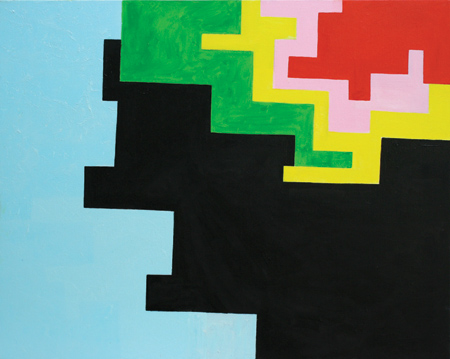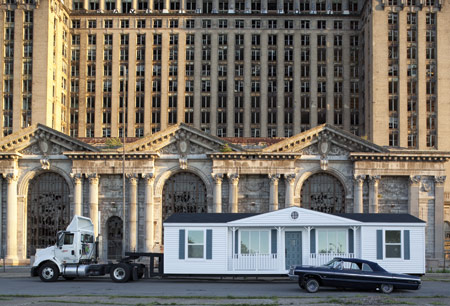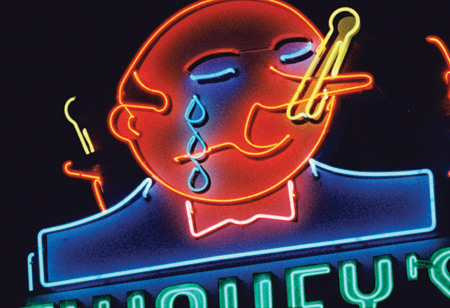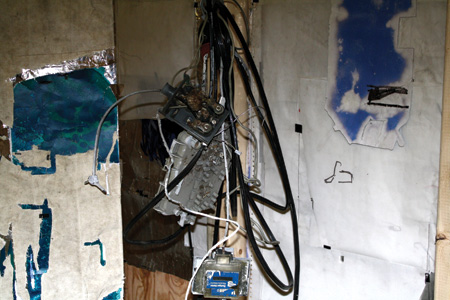The critics have been unusually effusive about this year’s Whitney Biennial. “This is one biennial you actually need to see,” writes Emily Nathan at artnet.com. Peter Schjeldahl, The New Yorker’s consummate arbiter of contemporary art, called the show “enchanting” and said it’s one of the best biennials the Whitney has mounted in years. Similarly, Roberta Smith at the New York Times showed few restraints in her review, writing that the exhibition presents a “clarity of vision” and praising how it “tacitly separates art objects from the market and moves them closer to where they come from, artists, whose creative processes and passion for other artists’ work are among the show’s unstated yet evident themes.” Resting not so lightly on organic metaphors, Smith calls the show “a new and exhilarating species of exhibition, a curatorial life form.”
- “Whitney Biennial 2012.” Through May 27. Whitney Museum of American Art, New York.
Such enthusiasm for the show has focused on how curators Elizabeth Sussman and Jay Sanders redefined this enduring art event (they refer to it as an art festival). They’ve expanded the film program, given the visual and installation works more space in which to engage patrons, and transformed the museum’s fourth floor into a performance space with works by British choreographer and dancer Michael Clark and American dancer and curator Sarah Michelson, whose dance piece was specifically commissioned by the Whitney for the biennial and is anchored by the floor plan of the new Whitney museum downtown.
While critical enthusiasm has been loud, there have been more downbeat reviews. Howard Halle at Time Out professed his utter confusion at both the selected works and the gallery arrangements, complaining that this show “lacks the impeccable selectivity and narrative flow” of earlier shows. Halle usefully raises the point that so many of the works on display explicitly or implicitly turn towards art’s past more than its future. In a stark contrast to the other critics’ enthusiasm for the curatorial rebirth that this show offers, Halle views the butterfly as more a fearful turtle: “Doubling down on a longing for the past is the same as doubling down on fearing the future, and in this respect, the 2012 Biennial seems very afraid.”
These contrasting views of the show have one thing in common: They are all true. This show exists in a nexus of romantic enchantment, imaginative curatorial vision, a constantly shifting performance space, and a fearful longing for the past. These contradictions illuminate the challenging ways the show asks us to rethink our approach to contemporary art and, more important, how we talk about it. What so many of the critics avoid mentioning (out of fear, perhaps, or pure blindness) is how this biennial questions the very language and power of the critic.
One of the first objects I encountered in the show was a catalogue, perched on a short podium near the door of the second floor. It sat opened to an essay entitled “There’s No Place Like Home” by artist and educator Andrea Fraser. In the 1980s and ’90s, Fraser’s performance art critiqued the art world’s limited imagination and commercialization, questioning the reification of art through her precise feminist lens. In this dense but concise essay, which incorporates ideas from Freud and Bourdieu, Fraser reflects on a disturbing disconnect between how we (I’m using this pronoun cautiously here) so often grant contemporary art its radical social critique while ignoring the conditions upon which art is made, supported, circulated and valued. “The result,” Fraser writes, “has been an ever-widening gap between the material conditions of art and its symbolic systems: between what the vast majority of artworks are today (socially and economically) and what artists, curators, critics, and historians say that artworks…do and mean.” Fraser points to the very illusory gap in our discussion of art that allows, for example, Wall Street hedge fund managers to underwrite an exhibition of installation works that the gallery owners, critics, and agents (among others) come to define as radically critiquing, transforming, confronting, subverting, (pick your verb) our social or economic conditions all in a bid oftentimes to sell back to such hedge fund managers. How, Fraser provokes us to wonder, has our language about art become so distinctly removed from the material conditions that produce our art?
When I first approached this book, I was unaware that this catalogue was the catalogue for the show, transformed into its own art object. It was not until I reached out to pick it up that I realized it was laminated, the pages a solid mass, the text glued to its support. The guard yelled at me from across the wide expanse of the second floor: “Don’t touch!” Startled, I stepped back, realizing at that moment the catalogue was not a catalogue but rather an essay turned into art, complete with wall text and required patron distance. Later, I watched as other visitors repeated my action, grasping the book and recoiling at the guard’s sonorous words, an echoing chant that became part of the second floor gallery experience. It was all quite strange, but also provocative. Like so much of this show, it turns us away from what we have come to expect from this art event.
The catalogue does indeed provide its own form of artistic creation, for curators reinvented the usual practice of such exhibition texts that generally rely on the voice and insights of art critics and historians to comment on the works displayed. This dyadic relationship so often anchors the museum or gallery experience: artists display, critics discuss. But this catalogue changes such a dynamic, offering the discussion as art itself. Or, rather the catalogue is both discussion and art, bridging, in some small way, the chasm Fraser directs us to peer down into.
In the lobby bookstore, where you could actually touch the catalogue and flip through its pages, I discovered a compilation of interviews and poems, meditations and essays mixed with an archive of visual work, each part created by one of the 51 artists featured in the show, often in collaboration with other writers and artists. The intent, as Sussman notes in a conversation at the beginning of the catalogue, was to “move away from [a] kind of empty ‘artspeak’ and toward an idea of making the catalogue an extension of the exhibition rather than just a chronicle.” With the exception of these dialogues with curators; Fraser’s essay; and a short, considered essay by art historian David Joselit, most of the 317-page catalogue is given over to the artists themselves. Mixing fonts and layouts, the book’s visual and textual threads resist consistency, creating something more akin to a scrapbook or a kind of network of ideas that has no real starting or end point. It would take weeks to consider it all, much longer to make sense of the catalogue as a whole. But this is part of the point. This is a catalogue for the digital age. The expert “artspeak” gives way to loosely connected reflections and fragments of insights by the artists, each artist’s voice challenging us to come to our own conclusions, to make links and connections that are not pre-arranged.
This focus on the artists and the process of their work runs throughout the show. Andrew Masullo’s intimate colorful abstract canvases hold a particular attraction in free flow composition and the strong palette. The wall text describes Masullo as “a painter’s painter,” for his modest canvases “resist being confined by content or artistic movement.” Translation: He is not swayed by the demands of the marketplace.

“5030” (2008-10), Andrew Masullo/Daniel Weinberg Gallery
This somewhat romantic focus on the work of the artist is most acutely experienced in Dawn Kasper’s “This Could Be Something if I Let It,” which presents her studio space, piled and cluttered with books and DVDs, art supplies, CDs, and personal items, as part installation art and part performance. This project is an ongoing work that Kasper calls the “Nomadic Studio Practice Experiment,” in which the installation is her studio space. Kasper spends each day of the show in this makeshift studio, engaging patrons, working (if she can), introducing visitors to an actual artist at work in an actual studio (sort of). Walking through it, you feel a bit like a trespasser, though when I encountered the installation she was engaging and friendly to everyone who passed through. This reminded me of the natural history museum displays of the late 19th century with actual Eskimos in scenic dioramas for patrons to ponder their imagined otherness. “My time in process is very much an important part of my performance work, as is revealing that process publicly,” Kasper is quoted on the wall text. Translation: Few people really know what artists do. While the implied intent is to turn the private work of the artist into a public spectacle, Kasper’s installation reminds us how much space exists between artist and art, between creative labor and the object we experience in a museum or gallery.
Kasper’s nomadic wanderings echo in the work of documentary filmmaker Mike Kelley, whose film “Mobile Homestead” records his building a replica of his suburban Detroit childhood home, a white clapboard rancher that hugs low to the ground. He then transported the house around Detroit, providing a space for a community gallery and an ethnographic engagement with the different neighborhoods he encountered.

The “Mobile Homestead’ in Detroit (2010), Mike Kelley
Throughout the show, this concern for the mobile and the transitory qualities of both the art and the artists turn us again and again to two urban centers where a number of the artists live and work: Los Angels and Detroit. Thom Andersen’s essayistic films on Los Angeles — “Los Angeles Plays Itself” (2003) and “Get Out of the Car” (2010) — focus on both the movements and symbols of the city, layered with music and history, or rather what Andersen calls a “militant nostalgia” that strives to revive the city’s vanished history.

Still from “Get Out of the Car” (2010), Thom Anderson
Kate Levant’s abstract installation hangs along cable wires, dangling the detritus of canvas and electronics, insulation lining and large cardboard squares, all gathered from burned-out houses from Detroit’s inner-city. This work leaves us little to contemplate about its composition, for it is more about the decay it gestures toward, the histories and concrete places that have been destroyed.

“hive.tangle.jpg” (2011), Kate Levant/Zach Feuer Gallery
I found the many works that recalled history — artistic or cultural — to be the more provocative and complex of the show. Moyra Davey’s “Mary, Marie” (2011) presents 12 prints of envelopes that are imprinted with words from the letters 17th-century British writer Mary Wollstonecraft composed while traveling in Europe. The mother of Mary Shelley, who wrote the novel Frankenstein with its pieced-together protagonist, Wollstonecraft’s words are here rendered to mimic her original handwriting and placed on envelops that Davey sent out to family and friends. In her video “Les Goddesses” (2001), Davey narrates the story of Wollstonecraft and her daughters and Davey’s own history, offering a meditation on the connections between autobiography and history.
Richard Hawk’s collages, inspired by Japanese artist Tatsumi Hijikata’s butoh-fu notebooks, mix pencil letterings with cutouts of distorted bodily figures from modernist paintings by Klimt and Picasso. Born in the post-war years in Japan, butoh is a form of gestural dance, stylized and slowly performed so that the dancers bodies transform through distorted and twisted movements. Hawk’s small collages focus on the sexual and erotic qualities of such movements. They recount words from Jean Genet alongside the images, further layering these fragile forms with literary, visual, and dance traditions.
The show presents other encounters with the archive of art history, such as Forrest Bess’s canvases from the 1940s and ’50s. Their conceptualizing forms and diffused colors imagined a visual language for sexual realities beyond the male and female binaries. Bess’s colors and shapes are situated in mid-20th-century abstract paintings as much as they maintain their own particular vision. Elaine Reichek’s striking tapestry “Paint Me a Cavernous Waste Shore” (2009-10) reproduces Titian’s 16th-century painting “Bacchus and Ariadne” in bold colors and subtle details, created both by hand and by a digital loom. The wall text informs us that such work continues a “history that goes back to Charles Babbage and Ada Lovelace’s 19th-century plan for an ‘Analytical Engine,’ a predecessor of the computer that drew its principles from the Jacquard loom of 1801.” In such ways, the show imagines a creative tradition stripped of the art market, the galleries, and the critics. What such a tradition suggests is an unfiltered relationship between artists and patron (think Kasper’s studio), however ideal that might be.
Perhaps the most profound work in the show is the four-channel digital projection by Werner Herzog entitled “Hearsay of the Soul” (2012). The project mixes etchings of 17th-century Dutch artist Hercules Segers with an original composition by contemporary composer Ernst Reijseger for cello and organ and an excerpt of Herzog’s film “Ode to the Dawn of Man” (2011). The sequence of images transition between the musicians, the etchings, and the film. Large regular projections run along three walls; the music surrounds you in the expanse of the darkened room. You don’t hear the music so much as you feel it. And you don’t see the etchings as much as you experience them in this projected vastness. For Herzog, Seger’s landscape, with their introspective qualities, herald Modernism itself. The wall text quotes the filmmaker: Seger’s “landscapes are not landscapes at all; they are states of mind; full of angst, desolation, solitude, a state of dreamlike vision.” Combined with Reijseger’s beautifully haunting score that recalls the precise depth and sensuousness of a Bach fugue, the installation captures an aesthetic experience so fully anchored in the past that you wonder how it is here, in a show that promises a vision of the future of art.
There is much more to see here, more than I can explain, and certainly more than can be experienced in one single outing to the museum. Given the structure of the show, its performances and film showings vary from day to day and week to week, making any one experience of the Biennial incomplete. If completeness is what you are striving for, then this show will certainly disappoint. “I think people will most certainly need to come back several times as the show transforms to feel like they’ve gotten the whole experience,” Sussman says in the catalogue conversation. This need to return, this incompleteness of experience, makes any claims about the show suspect. Distrust Schjeldahl’s enchanting praise, or Smith’s enthusiasm, or even Halle’s confusion, the curators subtly hint. The experience is much too transitory to define in any particular way, to make any declarations by critics. It defies cohesion, even as you search for it in the catalogue. But this may be the point.
Sussman’s last experience with curating the Biennial was in 1993, when critics roundly revolted against the show’s politically precise works. The New York Times’s Michael Kimmelman declared directly in the second paragraph of his review: “I hate it.” Amidst the networks of social media, such defiant and aloof claims by critics are shrinking in force and meaning, as much as the critic is. Recently, Jonathan Jones reflected on his own role as art critic at the Guardian. “Criticism today is not about delivering truths from on high, but about striking a spark that lights debate,” Jones wrote. The role of the critic and what we say about art is so often mediated by a larger network of voices and ideas, and, as Jones noted, often times the artists themselves. While Jones still sees a place for the critic, it is no longer a position of expert authority, but rather more like an interlocutor. “The critic is clearly one voice among many,” Jones concluded, with a tone of nostalgia and uncertain anticipation.
Perhaps that’s all that we can say in the end: The 2012 Whitney Biennial is both enchanting and boring. It is forward-looking and fearful of the future. It is bold and timid. The show finds itself within this nexus of contradictions, in that uncertain chasm between how we talk about art and how we create it. It throws the creative process back at us, to grapple with its histories and complexities, provoking us to figure out a new approach, a new language that can capture the doing and meaning of art today. • 19 April 2012




